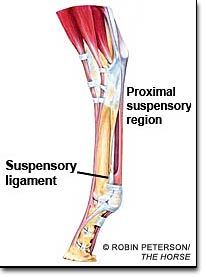| Home Medical Index Abstracts and Studies | First Posted Oct 27, 2009 Jan 21, 2020 | |
Suspensory Ligament Disorders in the Horse
PubMed [Article in German] Lischer ChJ, Bischofberger AS, Fürst A, Lang J, Ueltschi G. Pferdeklinik der Universität Zurich Lameness in horses due to pain originating from the proximal metacarpal/metatarsal region remains a diagnostic challenge. In cases of obvious lameness the pain can be localized to this region by diagnostic anaesthesia. Because a variety of disorders can cause lameness in this region different imaging modalities including radiography, ultrasonography and scintigraphy should be used to arrive at an accurate diagnosis. Even though a precise anatomic-pathologic diagnosis can still be an enigma, because not only bone and joints, but also soft tissue structures including the proximal suspensory ligament, its origin at the proximal metacarpus/ metatarsus, its fascia, the superficial fascia, as well as the intermetacarpal/metatarsal ligaments, the accessory ligament of the deep digital flexor tendon and both digital flexor tendons may be involved. Magnet resonance tomography (MRT) shows a high diagnostic sensitivity in imaging soft tissue structures and bone. In horses MRT is still at the beginning. The MRT appearance of the proximal metacarpal/metatarsal region has not yet been evaluated in detail and there are only few anatomic studies of the origin of the suspensory ligament in horses. The first experiences showed, that more gross and histologic examinations are necessary to fully interpret MRT-images and to differentiate pathologic alterations from clinically not relevant variations. PMID: 16509170 [PubMed - indexed for MEDLINE] For More Information: Veterinary Research on DSLDProximal Suspensory Ligament Disease of the Forelimb An Excellent Article. High Suspensory Ligament Equine Suspensory Apparatus Dysfunction Degenerative Suspensory Ligament Desmatis (DSLD) |